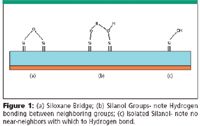Flexible Fused Silica Capillary: A Review of Internal Surface Chemistry
The Application Notebook
Synthetic fused silica capillary tubing has proven to be a vital component in many separation science techniques. Recently, it has expanded to serve an array of scientific markets. In most cases, an understanding of the internal surface chemistry is of fundamental importance.
Synthetic fused silica capillary tubing has proven to be a vital component in many separation science techniques. Recently, it has expanded to serve an array of scientific markets. In most cases, an understanding of the internal surface chemistry is of fundamental importance.
Chromatographers routinely use synthetic fused silica capillary as the backbone for GC, CE, Capillary LC, and MS. Additionally, medical device companies employ this capillary for a range of applications from drug delivery to optical fiber alignment. Scientists utilize it for mass flow control devices and fixed volume micro-reactors. In nearly every instance the internal surface chemistry must be considered. This application note discusses internal chemistry, with emphasis placed on key aspects and their references.
Discussion
Fused silica capillary is synthesized by the thermal oxidation of high purity Silicon tetrachloride, usually within an Oxygen-Hydrogen flame (see Equation 1). The resulting deposition product is low metal ion content Silicon dioxide. Once shaped into a tubular preform, this becomes the raw material substrate utilized to draw a wide range of capillary tubing products (1).
SiCl4 + O2 + 2H2 = SiO2 + 4HCl (Eq. 1)
During this draw process the fused silica is heated to ~1500°C, a softening point which allows for controlled cross-sectional reduction to the desired dimensional sizes. During this intense thermal processing, all physically and chemically absorbed water is removed from the internal surface resulting in a surface rich in bridged siloxane functionalities (see Figure 1a).

Figure 1
Left open to a moist atmosphere, or if rinsed with an aqueous solution, these siloxane bridges will react with water molecules, chemically incorporating them into the surface and resulting in the formation of silanol functional groups (see Figure 1b). These silanol groups form a polar surface which readily adsorbs additional water molecules, as well as other polar compounds. Note that silica is routinely used as a drying agent due its ability to confiscate water from the surrounding atmosphere. Thus, tubing ends are sealed upon manufacture to negate this effect during transport and storage.
The concentration of silanol groups is difficult to measure in a tubular capillary; however, it is reasonable to infer the silanol concentration is similar to that of high purity porous silica media, which has a reported value of 4.9 silanols/nm2 or expressed more commonly as 7.4μM/m2 (2). An undesired attribute is the presence of isolated silanol groups (see Figure 1c); these being silanol groups that have no near-neighbors with which to hydrogen bond. Although some isolated silanol may exist, their concentration is thought to be extremely low.
Populating the surface of fused silica with silanol groups is an important first step in many applications. Strong acid treatment prior to GC column manufacturing was studied by McNair (3). Conversely, strong base treatment is commonly employed in CE (4). If subsequent covalent chemical reactions involving newly formed silanol groups are desired, Polymicro recommends the capillary be thoroughly rinsed with water then heated to an intermediate temperature of 180°C while being purged with a dry, inert gas. Excessive heating will collapse neighboring silanol groups back into less reactive siloxane bridges.
Conclusion
As the chromatography market drives to smaller ID tubing, surface chemistries will play an increasing role in obtaining optimal results. For more information or to discuss your specific application, contact a Polymicro Technical Sales Representative.
References
1. The Book on the Technologies of Polymicro, 2005.
2. L.T. Zhuravlev, "Concentration of Hydroxyl Groups on the Surface of Amorphous Silicas" Langmuir, 1987, 3, 316–318.
3. M.W. Ogden, H.M. McNair, "Hydrothermal Treatment of Fused Silica Capillary Columns" J. High Res. Chrom. 8, (July 1985) 326–331.
4. J.W. Jorgenson, K.D. Lukacs, "Capillary Zone Electrophoresis" Science, 222, No. 4621, (Oct 1983) pg 266–272.

Polymicro Technologies
A subsidiary of Molex Incorporated 18019 N 25th Ave., Phoenix AZ 85023-1200
Tel: 602-375-4100; Fax: 602-375-4110
E-mail: polymicrosales@molex.com

Analysis of Greenhouse Gases by Gas Chromatography
May 15th 2024This application note demonstrates the use of SCION's 8500GC system for the analysis of key greenhouse gases—carbon dioxide, methane, and nitrous oxide—in a single atmospheric air matrix. Highlighting the system's excellent sensitivity and repeatability, this method is crucial for understanding emission sources and combating climate change.
Analysis of DEHP in Drinking Water by HPLC-DAD
May 15th 2024This application note outlines a method for detecting low levels of 1,4-Dioxane, a likely carcinogenic compound, in drinking water using SCION GC-MS technology. It details the procedure for analyzing water samples spiked with 1,4-Dioxane, achieving excellent sensitivity and low detection limits, demonstrating the method's effectiveness for environmental monitoring.
Plant Protection Product Impurity Screening by GC-FID with GC-MS Confirmation
May 15th 2024This application note from SCION Instruments delves into the meticulous screening of impurities in plant protection products using GC-FID, with GC-MS for confirmation. It emphasizes the necessity of identifying and quantifying impurities to comply with regulatory standards in industries such as pharmaceuticals, food, and agriculture. The study specifically examines eugenol, showcasing how to determine significant impurities for regulatory submission. The approach integrates GC-MS and analytical standards, ensuring precise impurity identification and quantification critical for product approval.